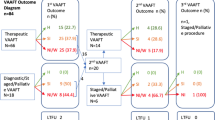Abstract
Background
Anal fistula is a common acquired anorectal disorder in children. Treatment methods that have been used are associated with inconsistent results and possible serious complications. In 2011 a minimally invasive approach, video-assisted anal fistula treatment (VAAFT) was described for adult patients. The aim of the present study was to assess the first series of pediatric patients treated with VAAFT.
Methods
All patients who underwent VAAFT between August 2013 and May 2015 were included. Demographics, clinical features, preoperative imaging, surgical details, outcome, and medium-term data were prospectively collected for each patient.
Results
Thirteen procedures were performed in nine patients. The male to female ratio was 8:1, and the median age was 9.6 years. Five fistulas were idiopathic, three iatrogenic, and one associated with Crohn’s disease. Eight complete VAAFT procedures were performed. The remaining five procedures were either fistuloscopy and cutting seton placement or fistuloscopy and electrocoagulation, both without mucosal sleeve. The median length of surgery was 41 min. The median hospital stay was 24 h, and the median length of follow-up was 10 months. Resolution of the fistula was observed in all patients who underwent a complete VAAFT. In four out of five patients who underwent an incomplete procedure (without mucosal sleeve), the fistula recurred. No incontinence or soiling was reported in the medium term.
Conclusions
VAAFT proved to be feasible and safe in children. It also proved to be versatile as it could be applied to fistulas of different etiologies. The key to success seems to be an adequate mucosal sleeve. Older children and adolescents benefit most from VAAFT which is a valid alternative to available surgical procedures.



Similar content being viewed by others
References
Meyer T, Weininger M, Höcht B (2006) Perianal abscess and anal fistula in infancy and childhood. A congenital etiology? Chirurg 77:1027–1032
Murthi GV, Okoye BO, Spicer RD, Cusick EL, Noblett HR (2002) Perianal abscess in childhood. Pediatr Surg Int 18:689–691
Ezer SS, Oğuzkurt P, Ince E, Hiçsönmez A (2010) Perianal abscess and fistula-in-ano in children: aetiology, management and outcome. J Paediatr Child Health 46:92–95
Peña A, Elicevik M, Levitt MA (2007) Reoperations in Hirschsprung disease. J Pediatr Surg 42:1008–1013; discussion 1013–1014
Festen C, van Harten H (1998) Perianal abscess and fistula-in-ano in infants. J Pediatr Surg 33:711–713
Christison-Lagay ER, Hall JF, Wales PW et al (2007) Nonoperative management of perianal abscess in infants is associated with decreased risk for fistula formation. Pediatrics 120:e548–e552
Amato A, Bottini C, De Nardi P et al (2015) Evaluation and management of perianal abscess and anal fistula: a consensus statement developed by the Italian Society of Colorectal Surgery (SICCR). Tech Coloproctol 19:595–606
Meinero P, Mori L (2011) Video-assisted anal fistula treatment (VAAFT): a novel sphincter-saving procedure for treating complex anal fistulas. Tech Coloproctol 15:417–422
Meinero P, Mori L, Gasloli G (2014) Video-assisted anal fistula treatment: a new concept of treating anal fistulas. Dis Colon Rectum 57:354–359
Afşarlar CE, Karaman A, Tanır G et al (2011) Perianal abscess and fistula-in-ano in children: clinical characteristic, management and outcome. Pediatr Surg Int 27:1063–1068
Novotny NM, Mann MJ, Rescorla FJ (2008) Fistula in ano in infants: who recurs? Pediatr Surg Int 24:1197–1199
Niyogi A, Agarwal T, Broadhurst J, Abel RM (2010) Management of perianal abscess and fistula-in-ano in children. Eur J Pediatr Surg 20:35–39
Charalampopoulos A, Zavras N, Kapetanakis EI et al (2012) Surgical treatment of perianal abscess and fistula-in-ano in childhood, with emphasis in children older than 2 years. J Pediatr Surg 47:2096–2100
Buddicom E, Jamieson A, Beasley S, King S (2012) Perianal abscess in children: aiming for optimal management. ANZ J Surg 82:60–62
Mattioli G, Pio L, Arrigo S et al (2015) Cone-like resection, fistulectomy and mucosal rectal sleeve partial endorectal pull-through in paediatric Crohn’s disease with perianal complex fistula. Dig Liver Dis 47:658–662
Schwandner O (2013) Video-assisted anal fistula treatment (VAAFT) combined with advancement flap repair in Crohn’s disease. Tech Coloproctol 17:221–225
Acknowledgments
This research project was funded by the Italian Ministry of Health with Cinque per Mille and Ricerca Corrente funding. The funder had no role in the study design, data collection and analysis, decision to publish, or preparation of the manuscript.
Author information
Authors and Affiliations
Corresponding author
Ethics declarations
Conflict of interest
The authors declare that they have no conflict of interest.
Ethical approval
No specific ethics committee approval was required given the absence of disease-specific guidelines or protocols in pediatrics.
Informed consent
Specific informed consent was obtained from the parents of all patients undergoing the VAAFT procedure.
Rights and permissions
About this article
Cite this article
Pini Prato, A., Zanaboni, C., Mosconi, M. et al. Preliminary results of video-assisted anal fistula treatment (VAAFT) in children. Tech Coloproctol 20, 279–285 (2016). https://doi.org/10.1007/s10151-016-1447-1
Received:
Accepted:
Published:
Issue Date:
DOI: https://doi.org/10.1007/s10151-016-1447-1




